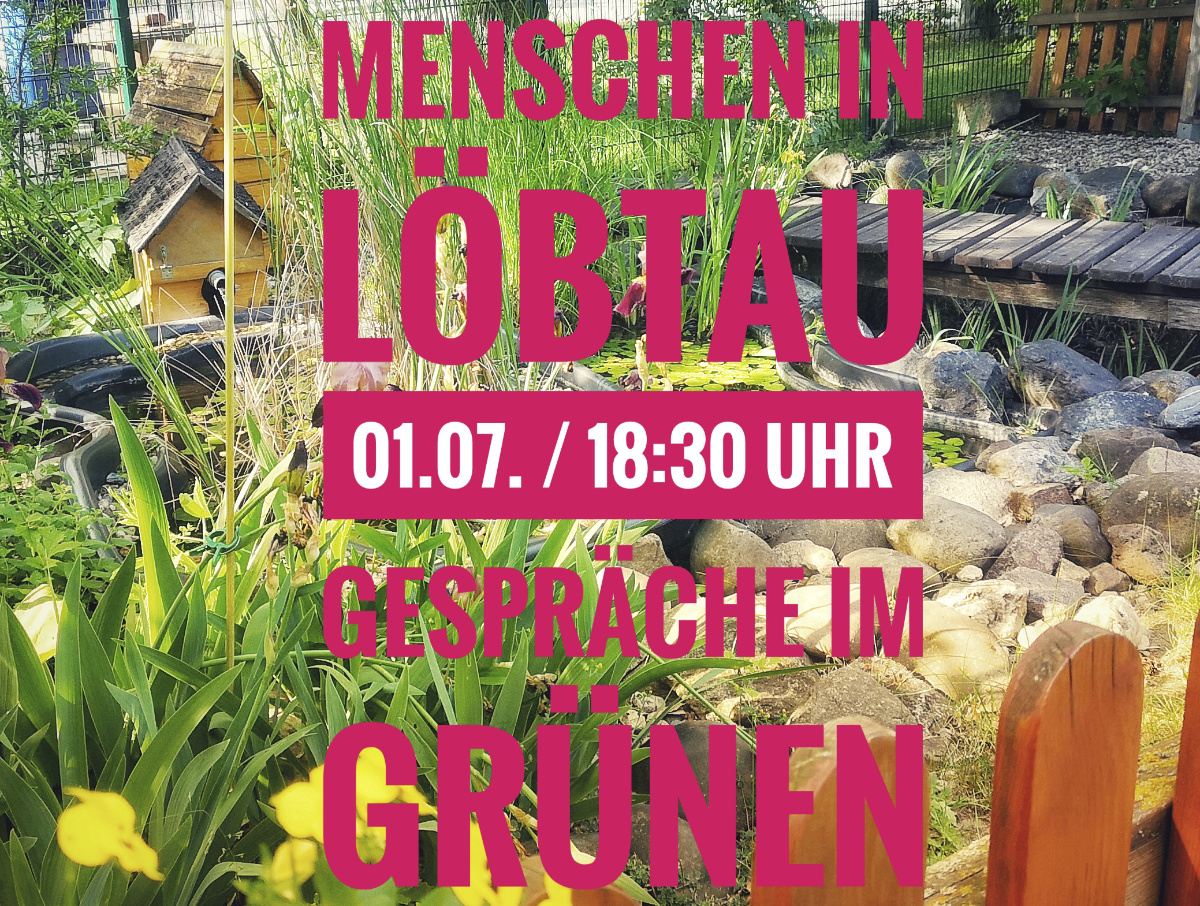“Liebliche Aue” – On 01 July Marlis Goethe led a tour through the Dresdner Nachbarschaften in Löbtau
Professionally, like a city guide, she keeps pictures and documents in transparencies ready to give us an insight into the village of yesteryear. For this we travel back to the 19th century. We start with Gottlob Werner, the geologist who gave Wernerstrasse its name. The geologist Werner, not Rötger Feldmann’s leg-holding Werner. And did it work with the catchy tune? Back to our district expert.
text: Rosa Hauch · photos: Yvonn Spauschus · illustration: Rosa Brockelt
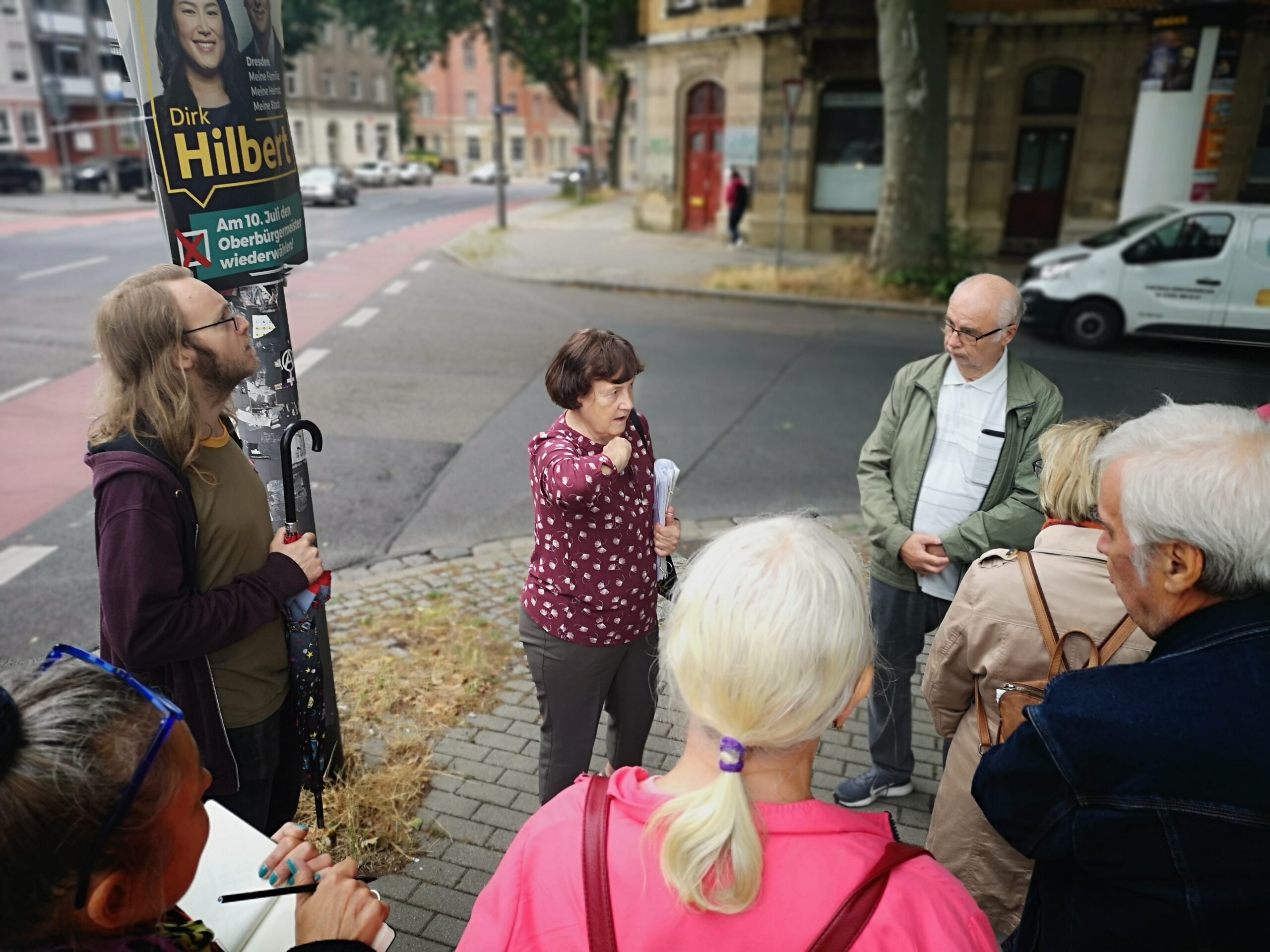
Marlis Goethe, like Goethe, came to Dresden in 1976. She was a teacher at the 36th secondary school in Dresden until 2014. She taught history, art and HTW. HTW here stands for household, technology and economics. So it’s no wonder that she knows all that. But it is not a matter of course that she shares her knowledge with us. District work is done on a voluntary basis, at the cost of her own time, energy and family. “Sometimes I have to tear myself apart,” she says, “I just can’t do everything. But with Marlis, a lot is possible.
On her way through the small streets off Kesselsdorf, Marlis remembers the so-called dance teas and can’t remember exactly whether she went into the restaurant “Zum Frieden” or just admired the plush carpet and turned back on her heel.
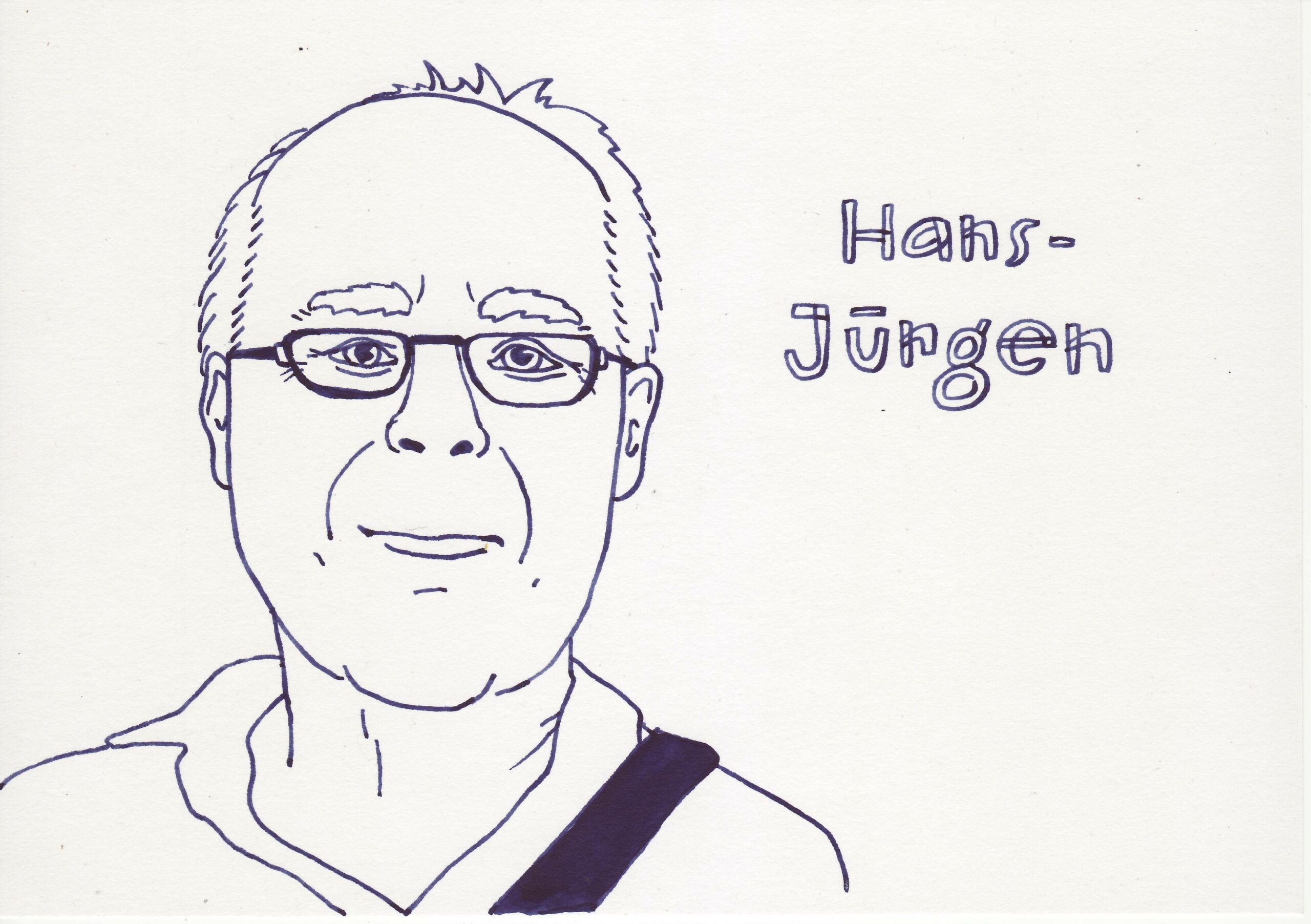


Clearly the wrong location for young people today. Hans remembers the old gas lanterns and how pretty they were. He doesn’t like the modern street lights. Hans and Marlis play information ping-pong. Each knows something about a place and in the end an interesting puzzle of Kuh-Löbte emerges.
Twelve large farmers had about 116 cows in 1750. It was a lot for that time. Napoleon’s troops stopped off in the village and could see far into the country from the bridges and hills. Who can imagine today that pasture land was characteristic of Löbtau? Over the course of time, very different factories had settled along the Weißeritz. Löbtau grew and grew into a wealthy municipality that had 39,000 inhabitants shortly before its incorporation in 1903. Today, about 20,000 people live in this Dresden district, which is one hundred years older than the city of Dresden itself.
Frosch-Cotta and Kuh-Löbte. After these stories, it makes sense to take a look at the history of your favourite neighbourhood the next time you move here. In the case of Löbtau, this is quite possible. There is a very active history association and a district house at Gohliser Straße 1, where you will always meet someone who knows a lot and is happy to pass on their knowledge.

The funny bird Hans
Hans, who plays memory ping-pong with Marlis, is called Hans Marburg. He is called Marabou, after the funny bird. He has probably had this nickname since the flag. When Hans served his 18 months in the NVA, Marabu was closer to his superior than Marburg, and now, years later, Hans is having fun with it. He likes to laugh and he likes to tell stories uff Säksch. He is particularly fond of the dialect poet and writer born in Leipzig in 1891. He always has a little book of Lene’s with him, from which he can read and quote in dialect, and is happy to do so for parties on invitation.
Regional market urgently needed
Walking through Löbtau, one notices which shops are new, which no longer exist, where the stamp shop used to be, who sold hats and tended beer gardens. The name of the Drei-Kaiser-Hof also plays a role again and again. Originally a hotel, it later became a cinema and still later a beer kiosk. A pharmacy is still named after it, but somehow there is no peace about it. The regional market, on the other hand, is far too quiet. The residents urgently want a small weekly market with regional products. So far, areas like the Mephisto meadow have always been discussed. Unfortunately, nothing has been planned and implemented yet.
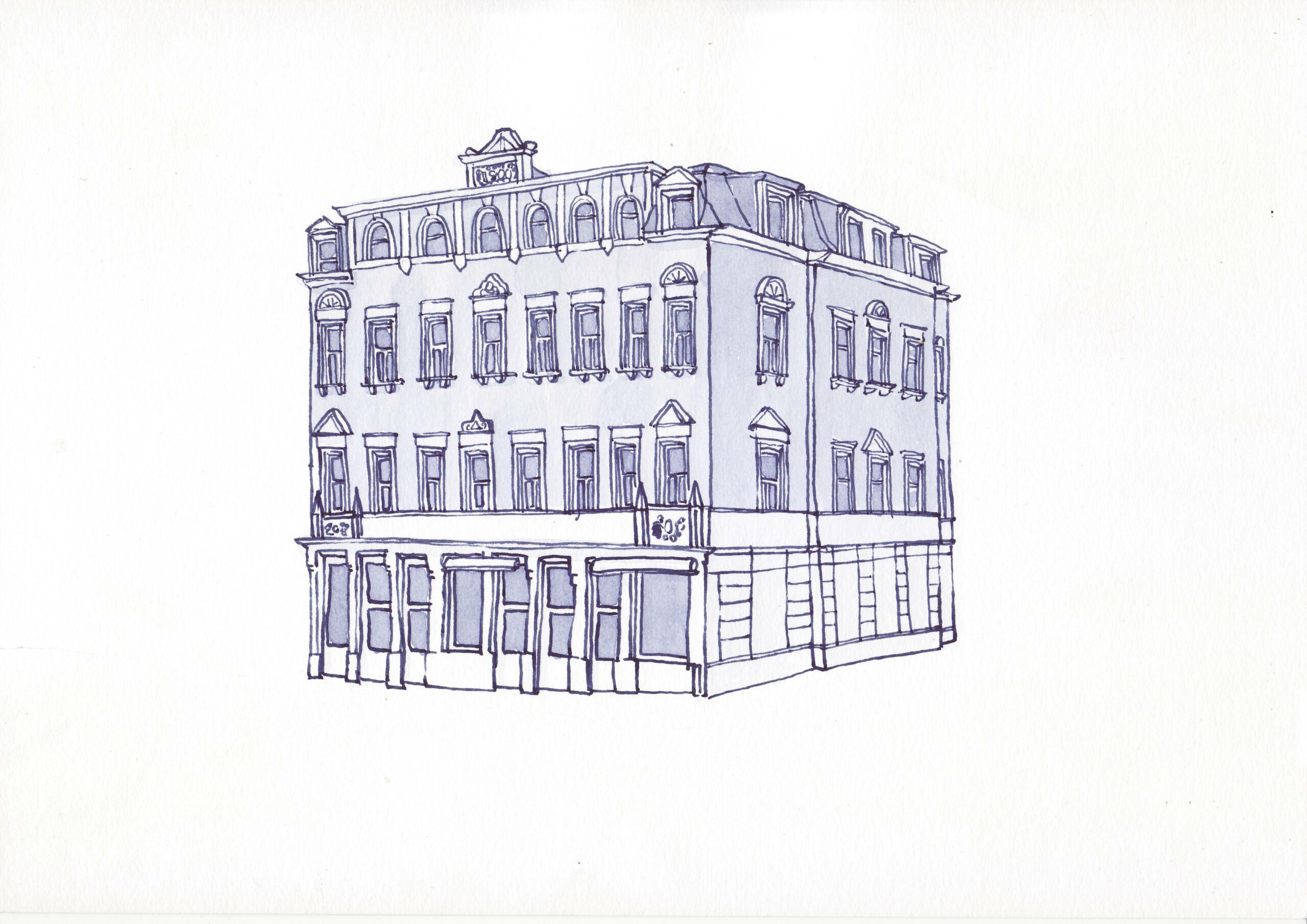
Of cube houses and dog kennels
Architecture always plays a special role, and in wealthy Löbtau, with the appropriate means, one could also afford something. Not only the cube houses in the old village centre still characterise the face of the district today, but also the Wilhelminian style houses and the Friedenskirche church have something characteristic about them. And as is so often the case, improvisation lasts the longest and can also be the source of ridicule. If you look up at the cross, you see a wooden building that has since been nicknamed “Saxony’s highest doghouse”. The shape explains everything.
Photo urgently sought
Löbtau, like Dresden, has its origins in Slavic history. Translated, the name means “lovely meadow”. The lovely meadow is divided into North and South Löbtau by Kesselsdorfer Straße, called Kellei. If we change the side of the street, we also change the place. And so we notice that something is missing. The small kiosk, right at the entrance to the Annenfriedhof, has been demolished. Unfortunately, the historical society does not have a photo of it. So if anyone is reading this text now and has a photo or knows someone who does, the Löbtau Historical Society would be very pleased.
Löbtop e.V. · Gohliser Straße 1 · 01159 Dresden
Stadtteilladen · AG Löbtauer Geschichte · Löbtauer Runde
chairpersons: Marlis Goethe, Rainer Leschhorn
mail: vorstand@loebtop.de · phone: 0171 5333259
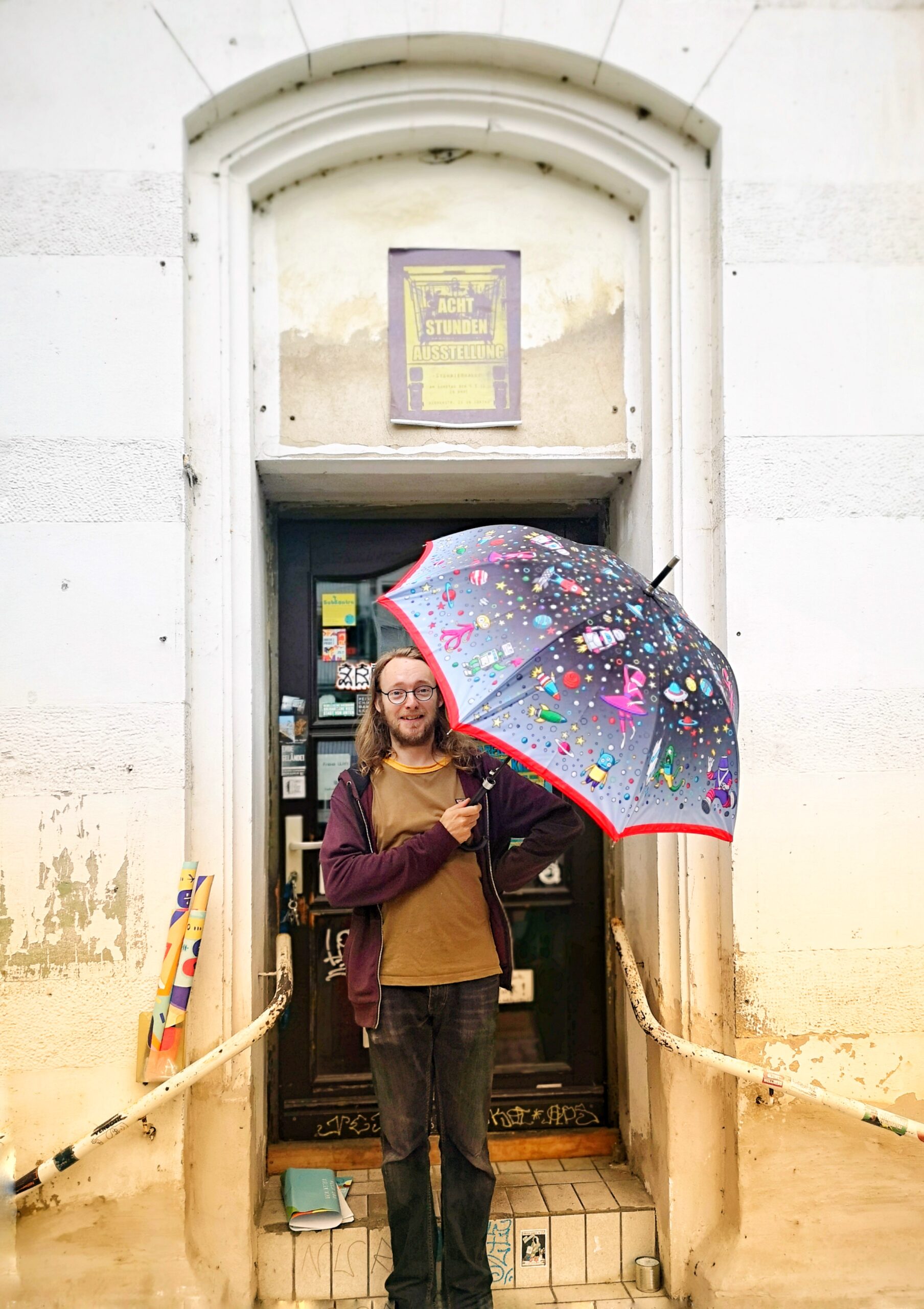
If you go, then you go, dear neighbours
Konstantin Fricke finds this consistent. He takes care of things here and feels responsible for keeping things running smoothly in the neighbourhood. Heating the oven, getting beer, making it cosy. Between 2015 and 2017, the Löbtau Language Café also found a home here. German is still being learned, today somewhat differently and in several places, but the neighbours always meet on Thursdays from 7.30 p.m. to chat, to be silent together or to help each other. Sometimes they cook for each other, sometimes they borrow tools. The association is financed by donations, the sale of drinks and membership fees. The next winter is sure to come, and a tiled stove like this is hard to beat for cosiness. Gemütlichkeit, by the way, is a word that only exists in German. You can’t translate it, but you can test it. Come and see us.
Liubituwa e.V. · Wernerstr. 22 · 01159 Dresden
Konstantin Fricke · phone: 0151 1247 0593
My life for Löbtau
He must be smiling. But for art, that’s what he still gives his life for. Peter-Michael Steyer was responsible for the catering at the Schauspielhaus from 1992 to 2009. He likes to remember conversations with Rolf Hoppe or Dieter Mann. He goes into raptures about professionalism, speech and voice training, drama school and thorough training. For 30 years, he worked for the Dresdner Musikfreunde association. This association shares the fate of many associations. At first, everyone is enthusiastic, makes programmes, develops new things and is constantly on the road. Then the first association members get older, can no longer travel, new association members do not join and finally the virtual file cover closes. Music lovers will find a new way to organise themselves or to meet and exchange ideas. But it will be different from the way Peter-Michael Steyer knows it. After all, it is also different what one wears as an opera or concert-goer. In his generation, people dress up and get the good suits and dresses out of the wardrobe. The young opera audience often wears jeans with a used look and thinks nothing of it. “Is that so right?” asks Peter-Michael Steyer and follows up with the facts about the career changers. “Stephanie Stumpf still learned and studied everything from scratch. She graduated with a diploma in acting in 2006. You can see that too.” It’s probably like everywhere else in the arts. You can’t do it without talent and you can’t do it without learning. Speaking of learning: who knows that Otto Dix had his flat, mistress, daughter and studio in Kesselsdorfer Straße? Peter-Michael Steyer knows and reports that he first became aware of this during a holiday at Lake Constance. On this occasion, he remembers a documentary film about Dix from 1965 and definitely wants to go to Gera to follow in the footsteps of Otto Dix.
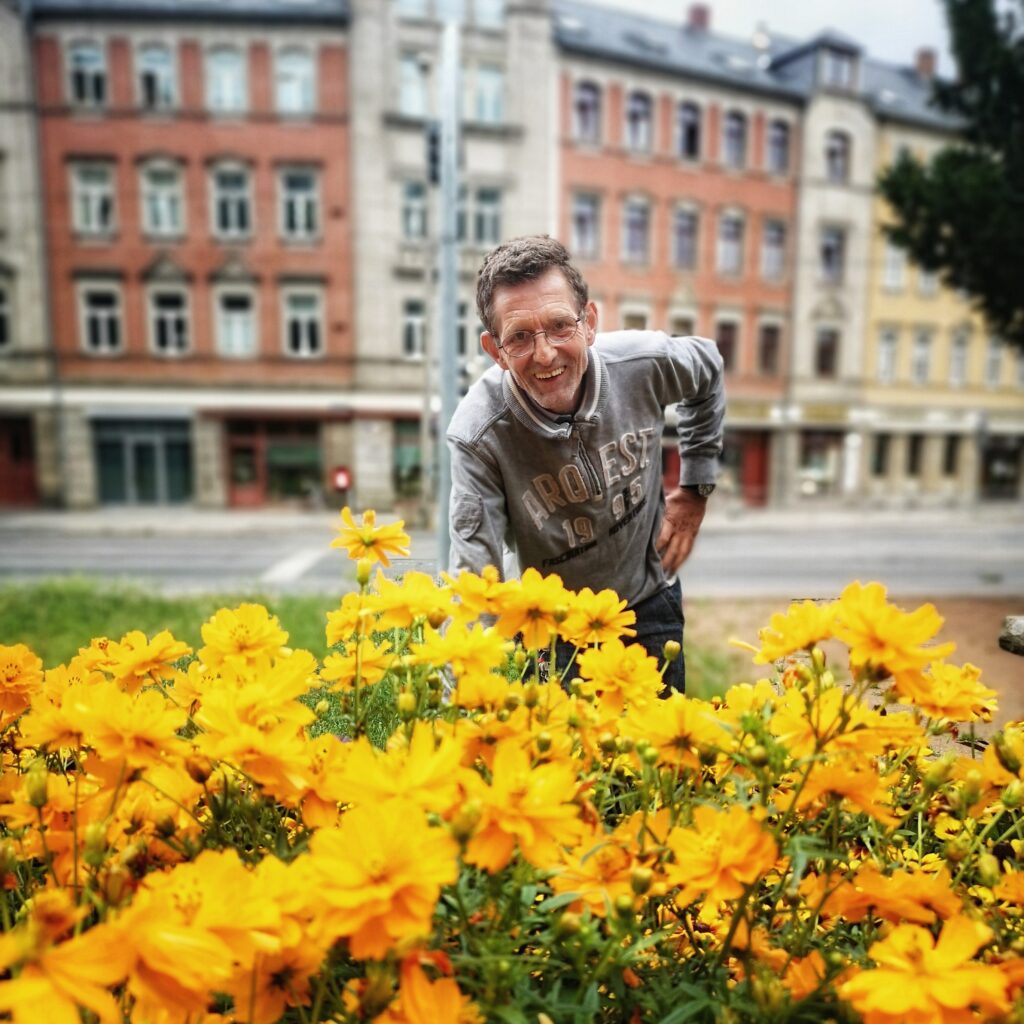
Green thumbs for former pasture landscape
Gardening connects and gardening is fun. There are three community gardens in Löbtau. These are the Columbus Garden, the garden on Emil-Ueberall-Strasse 6 and the Annen Garden, just behind the cemetery wall on an area that would lie fallow without this garden.
Everyone is welcome to garden, with or without gardening experience, with or without a green thumb. What counts is sowing and harvesting together, tending and meeting, playing and barbecuing. Since 2014, 300 square metres have been available in the Columbus Garden.
Bürgergarten Columbusstraße · Columbusstraße/Ecke Eichendorffstraße · 01159 Dresden
Sascha Latzkowski & Anja Grumbach
mail: buergergarten@gmail.com · phone: 0177 5141271
Almost twice as large, with 650 square metres, is the Annengarten, founded in 2019. You can find this urban garden by going through the main entrance of the cemetery and keeping to the right. Open garden time is always Wednesday and Friday from 4-6pm. Here everyone takes care of everything. Herbs, fruits, berries, vegetables thrive because landscape architects like Manu also provide professional support. Manu does not take it for granted that the parish gives away some of its land. That’s why the gardeners also organise work for the cemetery. They have put up nesting boxes and achieved a deadwood hedge. Other projects are being planned. Manu has observed that many young people from New Loebtau play with their children in the cemetery.
Annengarten (Neuer Annenfriedhof) · Kesselsdorfer Straße 29 · 01159 Dresden
mail: annengarten@ufer-projekte.de
People meet at the International Emil-Ueberall Garden every Friday from 5 p.m. to work and exchange ideas. Löbtau e.V. has made integration a priority for the districts of Löbtau and Naußlitz. There are various working groups in the association and there is almost certainly always the right contact person for the various questions about how things are in the neighbourhood. If you don’t know something yourself, you know someone who knows someone who can help.
Internationaler Emil-Ueberall-Garten | Willkommen in Löbtau e.V.
contact vie GartenNetzwerk Dresden (dresden-pflanzbar.de)
01.07.2022 · Neighbourhood walk in Löbtau
Stadtteilladen (Löbtop e.V.)
01.07.2022 · Storytelling café in Löbtau
Annengarten (UFER-Projekte Dresden e.V.)
Dresdner Nachbarschaften
Damals, Heute, Morgen / Zuhören, Erinnern und Gestalten
In our storytelling cafés and discussion groups, district tours and workshops, we want to encourage you to tell stories and develop visions.
Period
05-12.2022
Project coordination
Yvonn Spauschus (project management)
Anne Ibelings · Moussa Mbarek · Nadine Wölk (workshop leader)
Uta Rolland · Rosa Brockelt · Rosa Hauch · Falk Goernert (moderation and documentation)
Cooperation partners
JugendKunstschule Dresden · Omse e.V. · Löbtop e.V. · Quartiersmanagement Prohlis, Johannstadt and Gorbitz · Sigus e.V. · In Gruna leben e.V. · UFER-Projekte Dresden e.V.
Supported by

The project is funded by the House of Resources Dresden+


